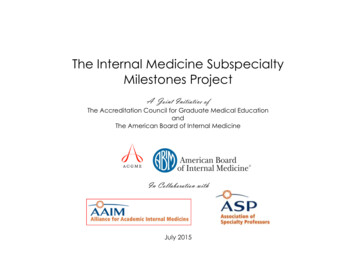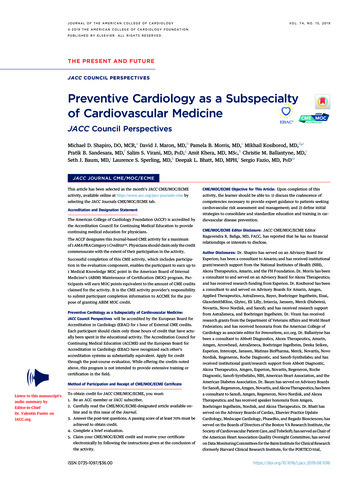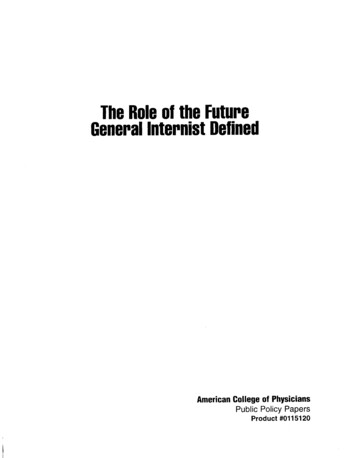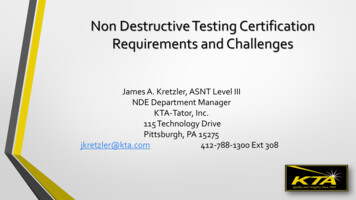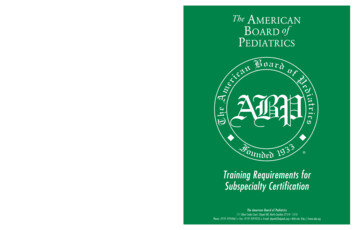
Transcription
AMERICANBOARD ofPEDIATRICSThe Training Requirements forSubspecialty CertificationThe American Board of Pediatrics111 Silver Cedar Court, Chapel Hill, North Carolina 27514 - 1513Phone: (919) 929-0461 · Fax: (919) 929-9255 · E-mail: abpeds@abpeds.org · Web site: http://www.abp.orgThe American Board of Pediatrics111 Silver Cedar Court, Chapel Hill, North Carolina 27514 - 1513Phone: (919) 929-0461 · Fax: (919) 929-9255 · E-mail: abpeds@abpeds.org · Web site: http://www.abp.org
Guidelines for Combined Training in Adult andPediatric SubspecialtiesJanuary 2004The American Board of Pediatrics (ABP) has completed an extensive review of the duration, design, and contentof fellowship training, with wide-ranging input from individuals and organizations with an interest in graduatemedical education in the subspecialties of pediatrics. The upcoming changes in subspecialty training requirementsthat have been approved by the ABP and outlined in this document are designed to recognize the diverse roles thatsubspecialists play, to allow greater flexibility in the design of fellowship training, and to place greater emphasis onthe evaluation of fellow training at the local level.The American Board of Internal Medicine (ABIM) and the American Board of Pediatrics (ABP) have agreed thatindividuals who are graduates of combined training programs in internal medicine and general pediatrics may completetraining in a subspecialty of each board in one year less than would be required of full training in both subspecialties.The one-year reduction in total training time is possible by double counting a year of research that is applicable toand supervised by both the internal medicine and pediatric subspecialty directors.The ABP endorses the goal of fellowship training remaining the development of future academic pediatricians andwill continue to require scholarly activity during fellowship training but will modify the requirement for meaningfulaccomplishment in research to accommodate a wider variety of academic scholarly activities.Although the clinical training requirements in pediatric subspecialties are not specifically delineated, it is understoodthat a minimum of one year of clinical training is required. Some subspecialties of pediatrics (including cardiologyand gastroenterology) require more than one year of clinical training for a fellow to be able to attain the clinicalcompetencies necessary to practice that subspecialty. At least 12 months of clinical training is required for the internalmedicine subspecialties, except for adult gastroenterology that requires 18 months, and adult cardiovascular diseasethat requires 24 months. Individuals in combined subspecialty training would be expected to meet the same clinicaltraining requirements as those in standard internal medicine or pediatric subspecialty programs.The new training requirements as outlined will apply to fellows beginning subspecialty training July 1, 2004,and thereafter. Those fellows who complete training by June 30, 2004, must meet the requirement for meaningfulaccomplishment in research, which was in place at the time they entered training.For most subspecialties (eg, pulmonology, hematology-oncology, rheumatology), a proposal for combined trainingmust include delineation of how longitudinal (continuity clinic) experience will be accomplished in both the pediatricand adult medicine subspecialty.The ABP will allow two options for those fellows who are currently in training or who have interrupted training (ie,those who began training prior to July 1, 2004, and who will not have completed training by June 30, 2004). Theseoptions are:To meet the requirements for application for a subspecialty certifying examination in pediatrics, an individual mustfirst be certified in general pediatrics. In addition to successfully completing the required training, the programdirectors of both subspecialty programs must verify that the individual completed the necessary training and that he/she is recommended to take the certifying examination. The individual would also be required to provide to the ABPevidence of meeting the meaningful accomplishment in research, required of all pediatric subspecialty candidates.A.B.Fulfill the requirement for meaningful accomplishment in research, which was in place at the time trainingbegan. Approval of the research submission will be made by the ABP. (See General Criteria for Certificationin the Pediatric Subspecialties, July 2003)Meet the new training requirements as outlined in this document, provided there is a Scholarship OversightCommittee in place for a minimum of 24 months to oversee scholarly activity and judge whether it meetsthe requirements of the ABP.A proposal for combined subspecialty training of an individual, which includes an outline of training in each specialty,should be submitted to each board for review. The proposal should be prospective, submitted either before trainingbegins or in the first three to six months of fellowship training. The boards will not approve programs for combinedtraining; rather, the boards will only consider training proposals for individuals in combined subspecialty training.1/01Questions regarding the new subspecialty training requirements may be directed to Dr. Gail McGuinness, SeniorVice President of the American Board of Pediatrics (gmcguinness@abpeds.org).James A. Stockman III, MDPresident223
Research/Scholarly ActivityMeaningful accomplishment in research or, for those beginning subspecialty training July 1, 2004, and thereafter,scholarly activity will remain a requirement for candidates in the dual certification pathway. The research or scholarlyactivity need not be related to both areas of training, although that would be the most appropriate scenario. Ifmeaningful research had been demonstrated prior to entry into this pathway (eg, possession of a PhD), approval ofboth subboards would be needed to acknowledge satisfaction of the requirement. Fulfillment of this requirementwould not, however, allow additional shortening of the four-year program.Candidates who apply for the dual certification pathway must have their research or scholarly activity projectdiscussed with and approved by both training program directors. The applicant and program directors must supplya written description of the proposed project before or by the end of the first year of dual training to the CredentialsCommittees of the subboards involved.CONTENTPageTraining Requirements for Subspecialty Certification.4Background. 8Training Pathways to Achieve Eligibility for Certification in Pediatric Subspecialties (table).11Special SituationsThe dual certification pathway would not be open to applicants via the Special Alternative Pathway.This program would not be open to internal medicine/pediatrics graduates who desire dual subcertification in bothpediatrics and internal medicine.An individual who has already completed three years of training and been certified in one subspecialty, has met therequirement for meaningful accomplishment in research or scholarly activity, and now wishes to become certifiedin another subspecialty must complete two years of training in that subspecialty.Participating SpecialtiesSpecial Alternative Pathway (SAP).12Integrated Research Pathway (IRP).14Accelerated Research Pathway (ARP).18Subspecialty Fast-tracking.20Dual Subspecialty Certification Guidelines for Development of Training Proposals.21Guidelines for Combined Training in Adult and Pediatric Subspecialties.23Candidates and program directors in any of the subspecialties may apply for the dual pathway, but it will be up tothe subboards of those specialties to decide whether the combination is feasible. Primary considerations will be theclinical training requirements for both subspecialties and whether a four-year block will allow successful completionof all requirements.Approved: 2/9/97Revised:12/03223
American Board of Pediatrics:Changes in Training Requirements forSubspecialty CertificationSummary of Subspecialty Training Requirements for Fellows Beginning Training July 1, 2004Dual Subspecialty Certification Guidelines forDevelopment of Training ProposalsIn the rapidly changing milieu of medicine today, it is clear that there are necessities and distinct advantages forsome physicians to obtain dual subspecialty certification. Upon the recommendation of the subboard chairs, anad hoc committee was formed to discuss and formulate guidelines for dual training. The recommendations of thatcommittee were amended by the subboard chairs.What follows are the changes approved by the American Board of Pediatrics (ABP) for its training requirementsleading to subspecialty certification. These training requirements are based on the perceived best interests of thehealth and well-being of children. The goal of fellowship training will continue to be the development of futureacademic pediatricians, recognizing the diverse roles they now play. Additional background is provided on page 8.It should also be recognized that fellowship training programs must continue to incorporate into their curriculummastery of each of the six general competencies identified by the Accreditation Council for Graduate MedicalEducation (ACGME) (medical knowledge, patient care, professionalism, interpersonal and communication skills,practice-based learning and improvement, and systems-based practice). These requirements will apply to fellowsbeginning their training July 1, 2004, and thereafter.The following guidelines were developed to assist program directors and fellowship candidates in generating trainingproposals that would allow dual certification in pediatric subspecialties in as little as four years of fellowship training.These are generic guidelines. The Credentials Committees of both pediatric subspecialties need to approve thetraining proposals prospectively. Dual subspecialty training in four years may not be feasible in some pediatricsubspecialties.Requirements:Both programs must be accredited, unless the subspecialty does not yet have an accreditation process, by the ResidencyReview Committee of the Accreditation Council for Graduate Medical Education.1.Standard Fellowship Training PathwayA.The requirement for meaningful accomplishment in research is broadened to accommodate awider variety of scholarly activities.B.A clinical-only (focused clinical third-tier) pathway has not been approved. All fellows mustdemonstrate evidence of scholarly activity.C.The prerequisite for fellowship training leading to Board certification remains three years ofgeneral pediatrics training in a program accredited by the ACGME or the Royal College ofPhysicians and Surgeons of Canada (RCPSC).D.2.The duration of fellowship training in the standard fellowship pathway remains three years.Dual Training RequirementsBoth fellowship programs must be in the same institution; separation would not allow the integration necessary.The requests for dual subcertification must be prospective, before beginning dual training. Candidates who are in thefirst three to six months of training in one of the subspecialties may petition the subboards for waiver of this policy.A candidate who is beyond the first year of training may not apply because integration of the two specialty trainingprograms would not then be possible.The application for dual training must be approved by both subboards.The dual subspecialty training proposal must include a proposed program training outline signed by both fellowshiptraining directors or division chiefs and submitted to the subboards for approval.Clinical Training1.Scholarly Activities During Fellowship TrainingA.The duration of clinical training will be dependent on the pediatric subspecialties. Consideration must be givento, among other areas, the body of knowledge, technical skills, and importance of longitudinal assessment ineach subspecialty area. The Credentials Committees of both pediatric subboards must approve the trainingproposal, which includes the training outline indicating the clinical training experiences.Core CurriculumAll programs must include a core curriculum in scholarly activities. This curriculum shouldprovide skills that lead to an in-depth understanding of biostatistics, clinical and laboratory researchmethodology, study design, preparation of applications for funding and/or approval of clinical orresearch protocols, critical literature review, principles of evidence-based medicine, ethical principlesinvolving clinical research, and the achievement of proficiency in teaching. The curriculumshould lead to an understanding of the principles of adult learning and provide skills to participateeffectively in curriculum development, delivery of information, provision of feedback to learners,and assessment of educational outcomes. Graduates should be effective in teaching both individualsand groups of learners in clinical settings, classrooms, lectures, and seminars, and also by electronicand print modalities.4Duration2.IntegrationDual certification pathways must provide integration of training and core material to be able to compressmastery of common areas. The integration of core material must be demonstrated by the training programsinvolved in the dual pathway. The degree of integration must be approved by the Credentials Committees ofboth subboards. Consideration should be given to block assignments as well as outpatient clinic assignmentsduring the training period. Night and weekend call experiences should be interspersed throughout the fouryears in each subspecialty and should not count toward meeting the clinical time requirement.21
Subspecialty Fast-trackingA subspecialty fellow who is believed to have demonstrated meaningful accomplishment in research, either beforeor during residency, may have a part of the training requirement waived. Evidence of such accomplishment mightinclude a PhD degree or sustained research achievement culminating in the first-authored publication of a researchpaper in a peer-reviewed journal. The subspecialty program director may ask the Subboard to waive the researchrequirement or, for those beginning subspecialty training July 1, 2004, and thereafter, the requirement for scholarlyactivity and to reduce the time of subspecialty training by as much as one year. This petition must be made eitherbefore the beginning of training or during the first year of training. A candidate for this pathway must have completedthree core years of pediatrics in an accredited program in the United States or Canada. An individual who enterssubspecialty training via the Special Alternative Pathway would not be eligible for subspecialty fast-tracking.Furthermore, a subspecialty fellow who receives a waiver by the Subboard must complete at least two years oftraining in the subspecialty with at least one year of broad-based clinical training.The specialty subboards will develop additional content specifications for subspecialty examinationsbased on the competencies related to the core curriculum in scholarly activities.B.Scholarly ActivitiesIn addition to the core curriculum described, each program is expected to engage fellows in specificareas of scholarly activity to allow acquisition of skills in the critical analysis of the work of others;to assimilate new knowledge, concepts, and techniques related to the field of one’s practice; toformulate clear and testable questions from a body of information/data so as to be prepared to becomeeffective subspecialists and to advance research in pediatrics; to translate ideas into written and oralforms as teachers; to serve as consultants for colleagues in other medical or scientific specialties;and to develop as leaders in their fields.All fellows will be expected to engage in projects in which they develop hypotheses or in projects ofsubstantive scholarly exploration and analysis that require critical thinking. Areas in which scholarlyactivity may be pursued include, but are not limited to: basic, clinical, or translational biomedicine;health services; quality improvement; bioethics; education; and public policy. Fellows must gatherand analyze data, derive and defend conclusions, place conclusions in the context of what is knownor not known about a specific area of inquiry, and present their work in oral and written form to theirScholarship Oversight Committee (see below) and elsewhere.Revised 12/03The Scholarship Oversight Committee in conjunction with the trainee, the mentor, and the programdirector will determine whether a specific activity is appropriate to meet the ABP guidelines forscholarly activities. In addition to biomedical research, examples of acceptable activities mightinclude a critical meta-analysis of the literature, a systematic review of clinical practice with thescope and rigor of a Cochrane review, a critical analysis of public policy relevant to the subspecialty,or a curriculum development project with an assessment component. These activities require activeparticipation by the fellow and must be mentored. The mentor(s) will be responsible for providingthe ongoing feedback essential to the trainee’s development.C.Work Product of Scholarly ActivityInvolvement in scholarly activities must result in the generation of a specific written “work product,”which may include:A peer-reviewed publication in which a fellow played a substantial roleAn in-depth manuscript describing a completed projectA thesis or dissertation written in connection with the pursuit of an advanced degreeAn extramural grant application that has either been accepted or favorably reviewedA progress report for projects of exceptional complexity, such as a multi-year clinicaltrial205
D.Scholarship Oversight CommitteeReview of scholarly activity will occur at the local level. Each fellow must have a ScholarshipOversight Committee. The Scholarship Oversight Committee should consist of three or moreindividuals, at least one of whom is based outside the subspecialty discipline; the fellowship programdirector may serve as a trainee’s mentor and participate in the activities of the oversight committee,but should not be a standing member. This committee will:Determine whether a specific activity is appropriate to meet the ABP guidelines forscholarly activityDetermine a course of preparation beyond the core fellowship curriculum to ensuresuccessful completion of the projectEvaluate the fellow’s progress as related to scholarly activityMeet with the fellow early in the training period and regularly thereafterRequire the fellow to present/defend the project related to his/her scholarly activityAdvise the program director on the fellow’s progress and assess whether the fellow hassatisfactorily met the guidelines associated with the requirement for active participationin scholarly activitiesE.External OversightA program’s ability to provide a satisfactory scholarly experience for all trainees will be evaluatedperiodically, as described below.The Pediatric Residency Review Committee (RRC) of the ACGME will be asked toreview the training program’s structure as it relates to the scholarly activity requirements.External periodic peer review of the quality of the training environment related toscholarly activity, in addition to that undertaken by the RRC, is highly recommended.F.Responsibilities of the Training Program DirectorIn addition to meeting the requirements of the ACGME related to the six general competencies, theresponsibilities of the training program director shall include the creation of a core curriculum inscholarly activities, the identification of a mentor, the creation of the Scholarship Oversight Committeeresponsible for overseeing and assessing the progress of each trainee, and the verification to the ABPof the successful completion of training.G.Requirement for Application for the Certifying ExaminationUpon application for subspecialty certification, the ABP will require:Verification from the training program director that the clinical and scholarly skillsrequirements have been metSubmission by the fellow to the ABP of a comprehensive document describing thescholarly activity that includes a description of the fellow’s role in each aspect of theactivity and how the scholarly activity relates to the trainee’s own career developmentplanSubmission by the fellow to the ABP of the actual “work product” of the scholarlyactivity as described aboveSignature of the fellow, program director, and members of the Scholarship OversightCommittee on the submitted documents described above6General pediatric inpatient rotations (five months)Emergency room/acute outpatient care (four months)Term nursery (one month)Developmental-behavioral pediatrics (one month)Adolescent medicine (one month)NICU (three months)PICU (one month)Subspecialties (four months) - consisting of one month each in four different coresubspecialties required by the RRCThe 20 months of specified experiences must include four months of supervisory experience in both theinpatient and outpatient setting, as well as continuity clinic of one-half day per week. Except for theprovisions specified above, the training must conform to the program requirements for accreditation ofgeneral pediatrics residencies.2.Subspecialty Fellowship RequirementsSubspecialty training must be at least four years in duration and in a discipline for which the ABP offersa Certificate of Special Qualifications (CSQ). The duration of clinical training will be dependent on thepediatric subspecialty. It is understood that a minimum of one year of clinical training is required. Somesubspecialties of pediatrics may require more than one year of clinical training for a fellow to be able toattain the clinical competencies necessary to practice the subspecialty. All subspecialty trainees will beexpected to participate in a core curriculum in scholarly activity skills (eg, study design, statistics, principlesof evidence-based medicine, manuscript preparation, biomedical ethics, educational techniques). Traineeswill be required to meet the same standards for scholarly achievement as defined for those in the standardthree-year subspecialty fellowship training programs.Eligibility for CertificationTo meet the eligibility requirements for certification in general pediatrics, the trainee must satisfactorily completetwo years of core general pediatrics training (22 clinical months) and an additional year (11 months of clinicalexperience) in the subspecialty fellowship. Verification of clinical competence and training will be required fromboth the general pediatrics program director and the subspecialty training program director.Eligibility to take the subspecialty certifying examination will require completion of six years of total training (twoyears of general pediatrics and four years of subspecialty training). The subspecialty program director will be requiredto verify training dates, as well as clinical and research competence.Approved: 6/03Effective date: 7/0419
Accelerated Research Pathway (ARP)3.The current Integrated Research Pathway, Special Alternative Pathway, Subspecialty Fast-trackingPathway, and the Dual and Combined Subspecialty Training Pathways will continue. Descriptions ofthese pathways may be found beginning on page 11.4.A new pathway, the Accelerated Research Pathway (ARP), will be offered. Elements of the ARP include:General InformationThe Accelerated Research Pathway (ARP) is designed to accommodate and encourage candidates who are committedto an academic career as physician-scientists with a strong research emphasis in a pediatric subspecialty. Thispathway is not intended to be the only route to accomplish such a goal but provides flexibility and additional timefor research training during the subspecialty fellowship without lengthening training beyond six years. Candidatesentering the ARP may begin subspecialty training after completion of two years of general comprehensive pediatrictraining. A structured curriculum and close observation of the progress of the trainee during the core general pediatricstraining is essential. The length of subspecialty fellowship will be a minimum of four years. The availability of thispathway in any particular program will be at the discretion of the general pediatrics program director/subspecialtyfellowship program director. Although it may be advantageous for both general pediatrics and subspecialty trainingto occur in the same institution, this is not a requirement of the pathway. If training occurs in the same institution,it is advisable for the general pediatrics program director and the subspecialty program director to work in concertto monitor the progress of the trainee.1.2.There will be no specific eligibility criteria, with the exception that candidates must be committed to anacademic career with a strong research emphasis in a pediatric subspecialty.Candidates for this pathway should be identified early, preferably prior to the start of the PL-1 year but nolater than nine months into the PL-1 year. This is necessary so that the second year of training can be adaptedin such a way that specified curricular requirements in general pediatrics will be met.A.Two core years of general pediatrics training containing 20 months of specified experiences, toinclude four months of supervisory experience in both inpatient and outpatient settings:General pediatric inpatient rotations (five months)Emergency room/acute outpatient care (four months)Full-term nursery (one month)Developmental and behavioral pediatrics (one month)Adolescent medicine (one month)NICU (three months)PICU (one month)Subspecialties (four months, consisting of one month each in four different coresubspecialties required by the RRC)B.C.Two years of general pediatrics training, followed by four years of subspecialty training, so thatthe total required duration of training is six yearsGeneral and subspecialty training need not be taken at the same institution.D.Candidates in the ARP are eligible to take the General Pediatrics Certifying Examination after 11months of clinical subspecialty training.Candidates in the ARP are eligible to take the subspecialty certifying examination after thecompletion of six years of training (two years of general pediatrics and four years of subspecialtytraining).3.The program director and candidate will not be required to seek prospective approval by the ABP, but mustnotify the ABP by means of the tracking roster in May of the PL-1 year.E.4.There will be no mandatory screening examination.F.The ARP may first be offered to individuals entering the general pediatric residency training July1, 2004.5.Whether a trainee may remain in the pathway will depend on the assessment of the general pediatricsprogram director, who will be required to verify competence at the end of two years of core training. Theprogram director must be able to attest that trainee performance has been satisfactory and that the curricularrequirements have been met. The ABP suggests that the program director utilize the In-training Examinationresults at the beginning of the PL-2 year as a measure of medical knowledge competence. A score at orabove the mean of general pediatrics trainees nationwide would provide objective evidence of acquisitionof knowledge commensurate with length of training.G.All general pediatrics and subspecialty training programs are not expected to offer ARP. Thedecision to offer ARP is to be made by training programs interested in this pathway.11/10/03Training Requirements1.General Pediatrics Curricular RequirementsThe curriculum for the PL-1 and PL-2 years of general pediatrics training should include a broad exposureto the specialty and must include 22 months of clinical experiences, 20 months of which are specified. Theadditional two months of training will be at the discretion of the general pediatrics program director butshould not include electives in the intended subspecialty. The 20 months specified experiences will consistof the following:187
BackgroundIn February 2001, the Subspecialties Committee of the American Board of Pediatrics (ABP) began a series ofdiscussions dealing with how subspecialty fellows are trained and the eligibility requirements for ABP subspecialtycertification. The current eligibility requirements of the ABP are consistent with the principles expressed in theFederation of Pediatric Organizations (FOPO) Statement on Fellowship Training. The statement was first publishedin 1990 and was modestly revised in 1996; it has been adopted by all member organizations of the FOPO. The viewsexpressed in the statement have formed the template for the design of fellowship training and for the criteria used bythe ABP for determining eligibility for subspecialty certification.The 1996 FOPO Statement on Fellowship Training clearly notes that the Federation supports the concept that “theprincipal goal of fellowship training should be the development of future academic pediatricians and that the graduatesof pediatric fellowship training programs should be proficient in clinical care, direct and consultative; teaching; anda selected area o
The American Board of Internal Medicine (ABIM) and the American Board of Pediatrics (ABP) have agreed that individuals who are graduates of combined training programs in internal medicine and general pediatrics may complete training in a subspecialty of each board in one year less than w

